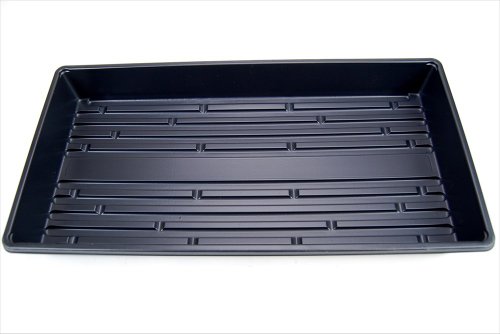Flood Tables and Grow Trays
Growing indoors traditionally or using soilless methods from start requires some specialized knowledge to get started. If you plan on building your own system or are looking at getting started, it’s important to know about the components needed to result in successful yields. An obvious, and somewhat overlooked component of hydroponic growing is the grow tray. In laymen’s terms, grow trays are needed for hydroponic grow systems to support the plants.
The grow tray is used to house the plant and grow medium in most cases. The grow trays are ideal for hydroponic seedlings, and supporting root systems of microgreens, wheatgrass, and more. Nutrients are delivered directly to the roots ensuring healthy plant growth. There are other accessories needed depending on which grow method you plan on choosing. Below are some hydroponic grow methods and how grow trays are used.

Hydroponic grow trays without drain holes, perfect for seedlings, wheatgrass, microgreens and more. Image via HydroponicGardening Center.com
- Wick System: trays are used to hold plants in this passive grow system to deliver the nutrient solution from the reservoir with a wick.
- Drip System: grow trays are used to hold plants. The submersed pump is used to drip a nutrient solution onto the base of each plant by a small drip line.
- Ebb and Flow: the ebb and flow system temporarily floods the grow tray with the nutrient solution and then the solution drains back into the reservoir.
- Nutrient Film Technique (NFT): nutrient solution is pumped into the growing tray that’s usually a tube and flows over the roots of the plants. This system also has the solution draining back into the reservoir.
- Deep Water Culture: doesn’t use grow trays, but rather a platform that holds the plants. The platform is usually made of Styrofoam and floats, with the roots submerged in the nutrient enriched solution.
Irrigation Systems
In these irrigation systems plants grow in individual rockwool blocks in shallow flood trays. The rockwool cube and roots of the plant get wet with nutrient solution when the tray is flooded. The solution drains back out to allow air into the cube and to then dry out. Irrigation usually only takes a few minutes because the rockwool acts like a sponge absorbing the nutrient rich solutions quickly.
Hydroponic flood methods such as NFT and Ebb and Flow, require flood tables for the solution to be cycled through on a regular, daily basis. Flood tables can be used for herbs, flowering ornamental crops, chili plants, and even cherry tomatoes.
Crops rooted in rockwool can be transplanted into potting soil, larger rockwool blocks or NFT and aeroponic systems which makes this application a popular process for large-scale commercial grow systems.
There are wide variety grow trays to choose form depending on what size you will need.Feature Image: Hydroponic grow trays for microgreens. Image via HydroponicGardeningCenter.com.